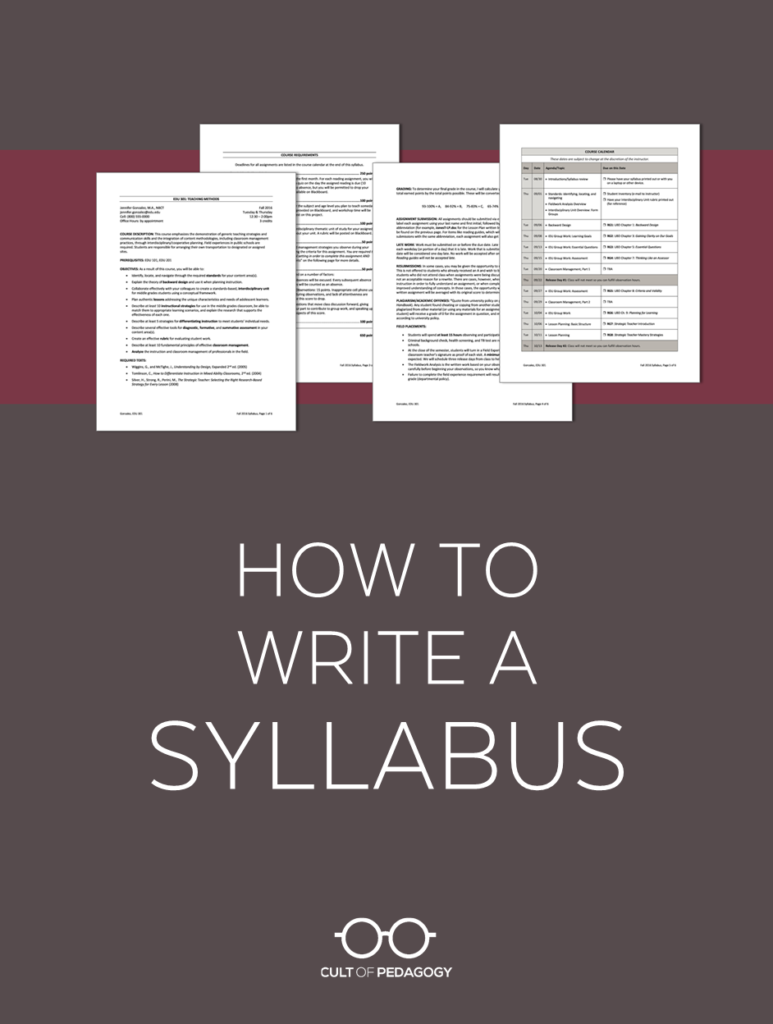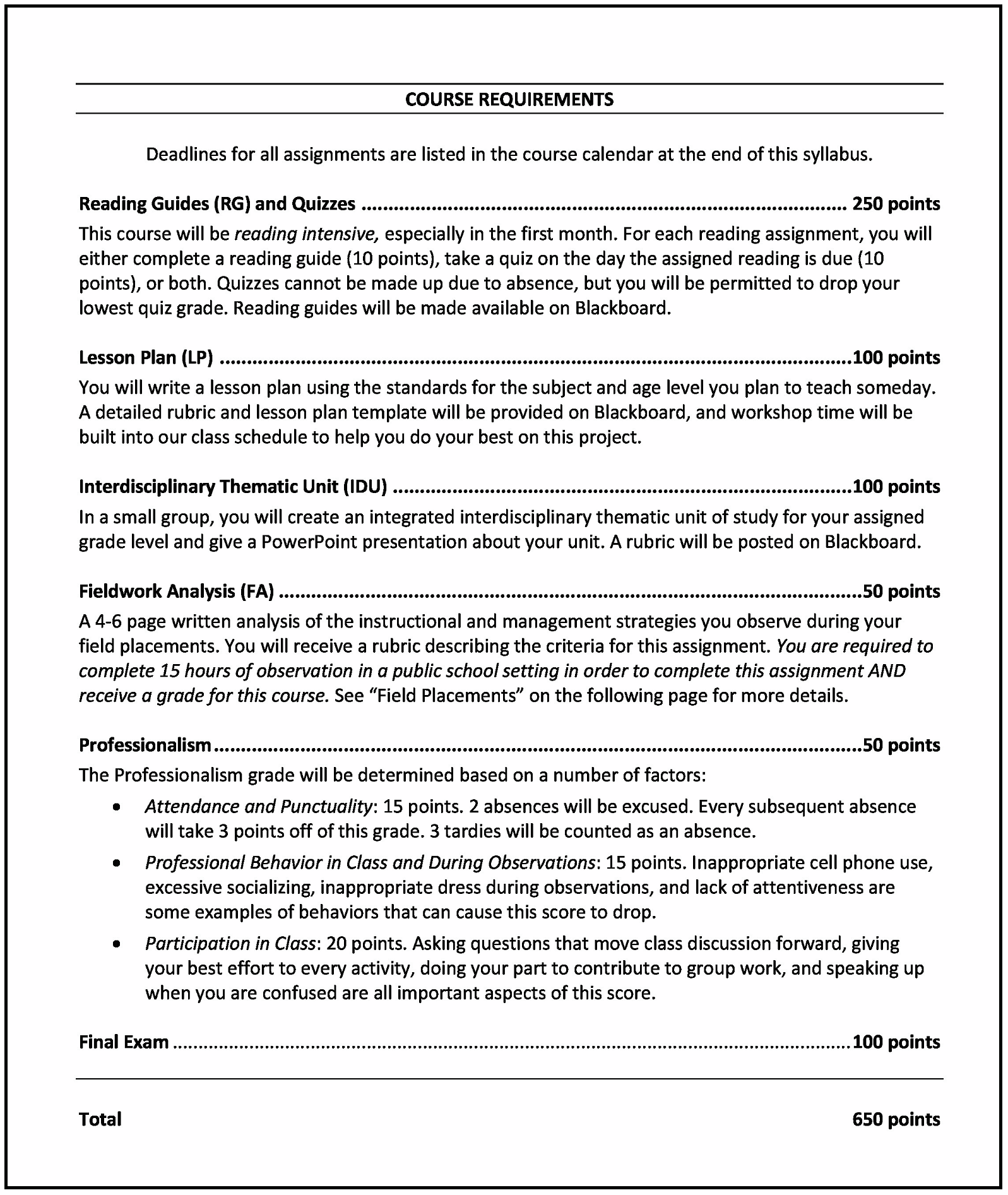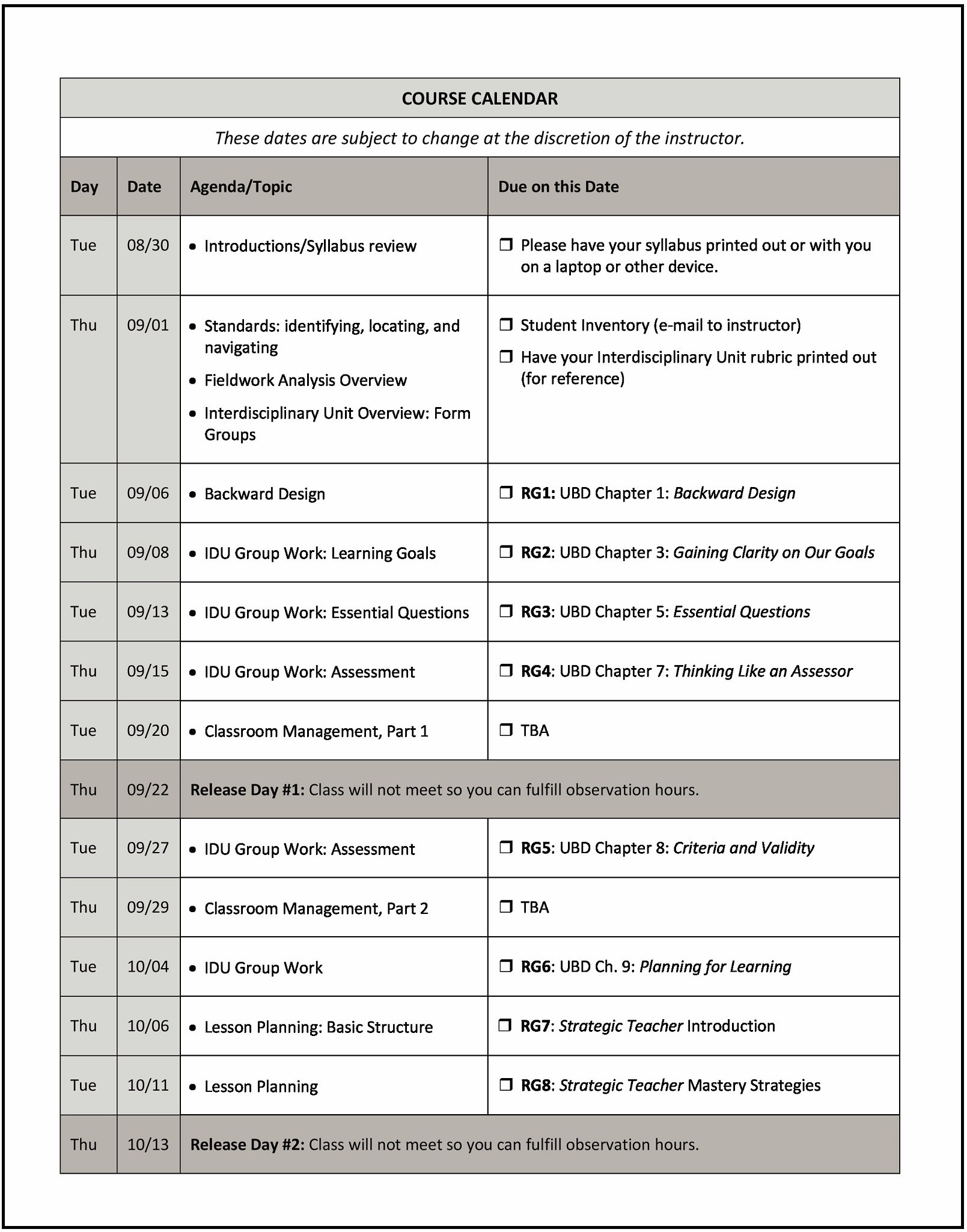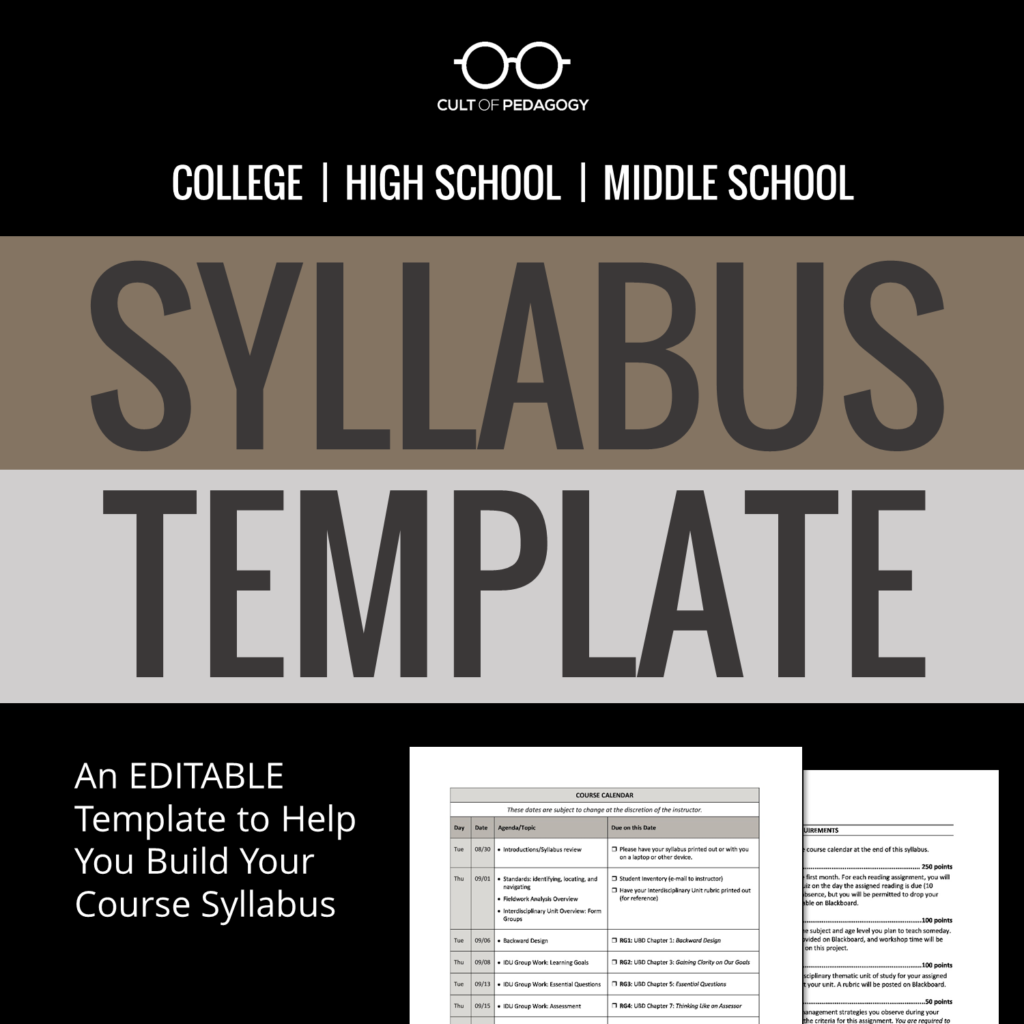How to Write a Syllabus

A well-designed syllabus is an essential tool for effectively managing a course. It gives students a clear understanding of your expectations and a road map for how the course will be conducted. When done right, a syllabus can prevent a lot of misunderstandings as the semester progresses.
As a middle school teacher, I put together a simple syllabus to communicate my plans and expectations to students and their parents. When I followed those years up with four years of college teaching, I had to take things to a new level: “The syllabus is seen as a legal agreement between you and your students,” my department head told me. It is a kind of contract. A promise. In other words, if a student ever wanted to contest their grade in my course, everyone involved in making the decision would refer to my syllabus to see whether I had kept up my end of the bargain. Whatever I wrote there needed to be something I could still stand behind months later.
With that in mind, it’s worth it to put some time and effort into your syllabus well before you ever meet your students, and to make it as thorough and detailed as possible.
In this post, I will share what I include in my own syllabi. I refined my own model over time, pulling from various sources and modifying things through trial and error every semester. It’s certainly not the only way to write a syllabus, but what I can say with certainty is that I had very few issues every semester in terms of students not understanding what was expected of them. No debates over how I calculated grades. No misunderstandings about when assignments were due. And even those few times, I was able to point those students to the syllabus, which they just didn’t happen to read very carefully. So if you’re looking for a syllabus writing model, this one will get the job done.
By the way, if you’re not too handy with page layout and would like a ready-made syllabus template, scroll to the bottom of this post.
Before Giving Your Syllabus to Students
It is essential that you get your syllabus approved by your administration prior to giving it to students, especially if this is your first time teaching in your current school. Doing this will ensure that your syllabus includes everything your institution requires, that it is in line with school policy, and that your administrator is aware of how you plan to handle certain situations.
At least a week before you share it with students, send your administrator a copy for his or her approval. Do this electronically so you have a record of the transaction. If you don’t hear back before it’s time to give it to students, send a follow-up email to get the approval. Although this all may sound like a bit much, and at the beginning of a school term, it may be hard to imagine any kind of trouble, there may come a time when a student issues a complaint about you; if your actions are in line with your syllabus, and you have it on record that your administrator has approved that syllabus, you can save yourself a lot of problems.
What to Include in a Syllabus
This list is for college, high school, or middle school syllabi. Items specific to college, but not necessarily applicable at the K-12 levels, are marked with an asterisk.
Your Details: Name, email, phone number, office hours*
Course Details: Course name, course number*, days and times the course meets, credit hours*
Course Description: A brief overview of what the course will cover for the term or year
Prerequisites/Corequisites: Any courses or other requirements that must be completed before taking this course. Corequisites are courses that must be taken at the same time as your course.
Objectives: Describe what the student should understand or be able to do as a result of taking your course.
Required Texts and Resources: List all required textbooks, other books, online resources and subscriptions, or other materials students must have to take the course.

Attendance Policy: Be very specific about what constitutes an excused absence, what constitutes a “tardy” (be sure to consider early departures as well…I had some students who regularly had to leave class early), and how these will impact student grades, if applicable. Make sure your policy is in line with your school’s policy.
Communication Protocols: Specify how often and through what channels students should be accessing course information, looking for updates and announcements, and contacting you. Because we have so many different means of communicating (online bulletin and discussion boards, social media, email and texting), it’s important to tell students exactly which channels they should be on for your course and how often you expect them to check those channels. For example, if you plan to post new information on a learning management system every Sunday night, tell students they should be checking the platform every Sunday night.
Electronic Device Policy: Explain your policy on the use of cell phones, laptops, and other electronic devices in class, including any information about whether exceptions are made for students with accommodations.
Food & Drink Policy: Are food and drinks permitted in class? Explain your policy here.
Accommodations Statement: If you are teaching at the college level, find out what you are required to include on your syllabus about accommodating individuals with disabilities.
Course Requirements/Assignment List: Describe how students will be graded in the course. What assignments will you give? Will there be tests and quizzes? If each one is worth a certain number of points, specify that here. I found that rather than try to weigh assignments or make them a certain percentage of the grade, it was simplest to just assign points to every assignment, including tests, then calculate student grades as a percentage of the total points possible.

Academic Policies and Procedures: Explain how assignments should be submitted, along with your policy on late work, resubmissions, and plagiarism/academic integrity.
Course Calendar: This probably requires the most work up front from you, but if you put the time in now to mapping out daily or weekly activities and due dates, you’ll be more likely to stay on track this term. If you aren’t sure about some activities, it’s okay to put TBA in those spaces; just having the spaces set up will help you and your students plan for the semester. It’s also a smart idea to include some kind of “subject to change” language about specific due dates and activities; this will give you some flexibility to adjust the schedule as needed.
This sample shows daily activities for a college course; if you are creating a calendar for middle or high school, it might make more sense to map your plans by the week instead of by the day.

How to Make Sure Students Read Your Syllabus
Simply handing the syllabus to students is no guarantee that they will read it. And delivering it electronically probably means even fewer eyes will actually make it to the last page. Students really should read your whole syllabus, so how can you make sure this happens?
Give them time: In my college classes, I would set aside about 5 minutes of the first class to allow students to read my syllabus. Just providing this time in class, rather than sending it home to be read, can significantly boost the number of students who actually read the thing. I asked students to read it with a highlighter and a pen, and to note any questions they had, which I would answer after the silent period was done. I would then give a brief lecture on the syllabus, covering some of the main points and explaining things that might be confusing to students.
Quiz them: Some instructors create a brief quiz over the syllabus, to make sure students read it carefully. I never did this, but not because I was opposed to it. I just preferred the next option.
Play a Game: Once students have read the syllabus, you could do some sort of game or activity to “test” their knowledge, like Crumple & Shoot or a scavenger hunt. Another option would be to have students teach sections of the syllabus to each other in a Jigsaw activity.
Get Signatures: It’s a good idea to have students (or their parents, if you’re teaching in a K-12 setting) sign a paper attesting that they have read and understood the syllabus. Although this doesn’t guarantee that they read the syllabus, it may provide you with some legal protection should a student or parent appeal something later on.
Course Syllabus Template
If you want to get your syllabus done quickly, my Syllabus Template will help you knock it out in no time. It includes an editable Microsoft Word template using the same style shown in the above screenshots, my own 6-page sample syllabus that can help you envision and craft your finished product, and a Syllabus Acceptance Form you can use to collect student signatures acknowledging receipt.

Join the Cult of Pedagogy mailing list and get weekly tips, tools, and inspiration—in quick, bite-sized packages—all geared toward making your teaching more effective and fun. You’ll get access to my members-only library of free downloadable resources, including my e-booklet, 20 Ways to Cut Your Grading Time in Half, which has helped thousands of teachers spend less time grading. If you are already a subscriber and want this resource, just check your most recent email for a link to the Members-Only Library—it’s in there!